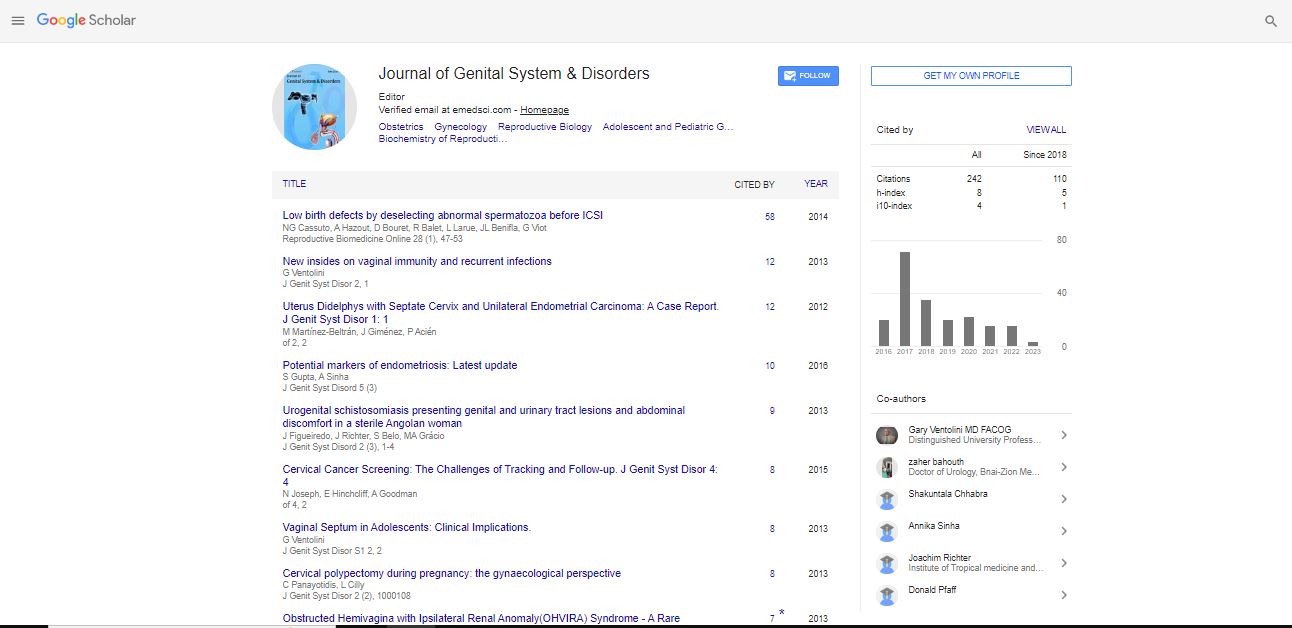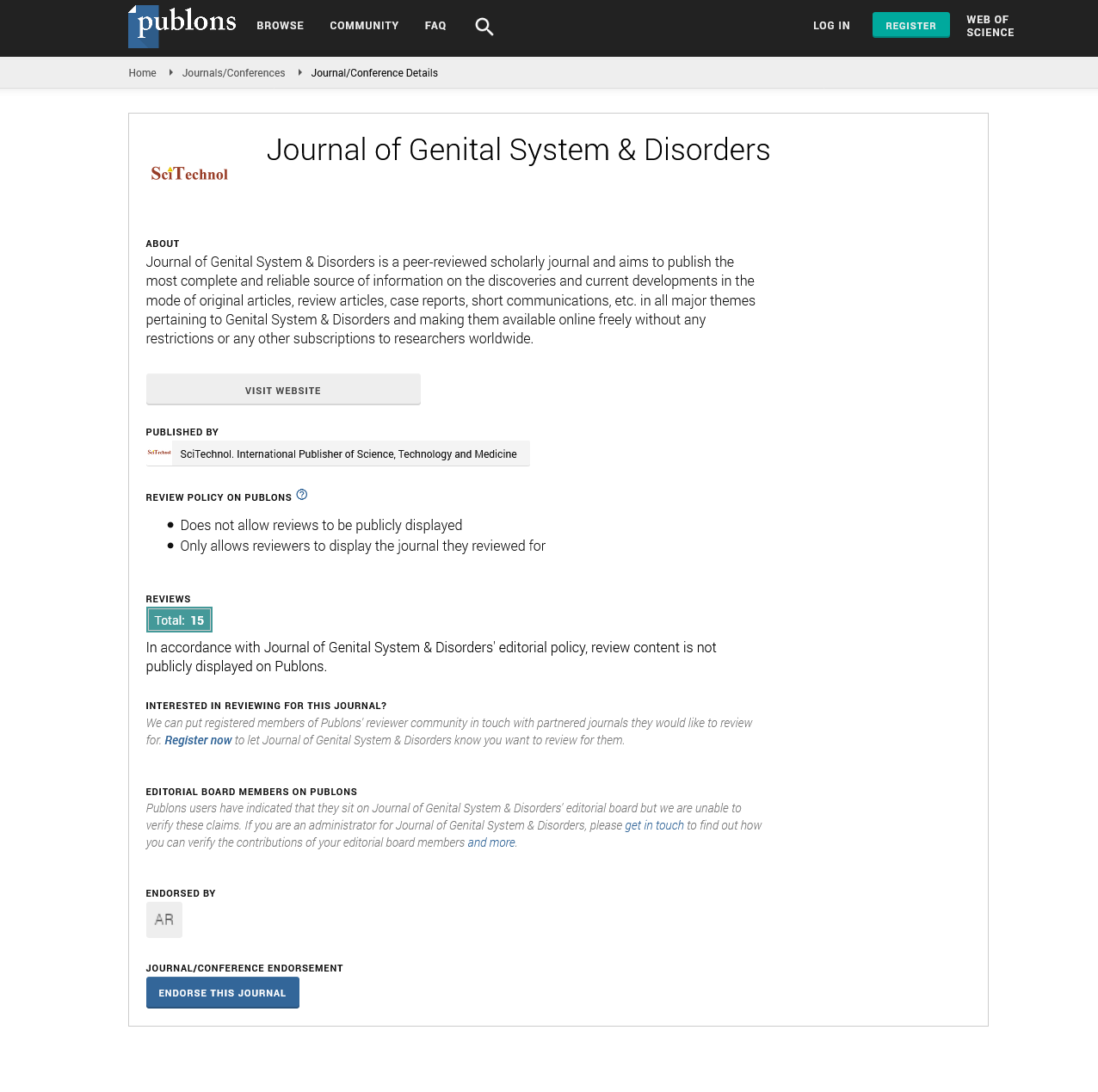Short Communication, J Genit Syst Disord Vol: 10 Issue: 4
Transopturator Tape for the Treatment of Stress Urinary Incontinence in Females
Zahraa Abdul Jaleel Al-Tamimi Al Iraqia University, Iraq
Abstract
Stress urinary Incontinence is defined as the involuntary leak of urine during efforts or exertion. It is reported to be affecting (4-35%) of women with successive increase in prevalence over age In our society the prevalence is probably higher considering the trend for multiparty from one side and the social conflict of declaring the problem on the other side, all on the background of the diminished availability of the specialized centers to deal with it. Our study sample included patients with the stress urinary incontinence (SUI); and mixed unary incontinence (MUI) that have been admitted for TOT operation in our hospitals in the above period whose case files turned to be having accessible and full data pre and up to one year post operatively, and those were randomly selected till the ceiling of SO was reached, of those 38 cases had pure stress, while 12 had mixed stress with the first being predominant by urodynamic study. Patient records were retrospectively investigated for the success rate (determined by subjective admittance of no more complaint of urine leaking upon exertion) both immediate and at one year follow up visit; for the postoperative complaints (immediate and at one year); as well as for variables that might affect the success, including: Patient demographic variables (age, parity, menopausal status, BMI) at time of surgery. Patient related clinical variables (concomitant systemic disease as Asthma, OM or being a smoker; or concomitant surgery at time of TOT) Data were statistically analyzed using the SPSS, statistical significance was assessed using the quoi square and P value, where a value of < 0 05 was considered to be statistically significant. Persistent incontinence postoperatively was assigned as a TOT failure Assessment of the study sample demography revealed: a median age of 49 (33-65); median BMI of 28.3; 65% of them being postmenopausal, 93% being multiparious.
Abstract: Stress urinary Incontinence is defined as the involuntary leak of urine during efforts or exertion. It is reported to be affecting (4-35%) of women with successive increase in prevalence over age In our society the prevalence is probably higher considering the trend for multiparty from one side and the social conflict of declaring the problem on the other side, all on the background of the diminished availability of the specialized centers to deal with it. Our study sample included patients with the stress urinary incontinence (SUI); and mixed unary incontinence (MUI) that have been admitted for TOT operation in our hospitals in the above period whose case files turned to be having accessible and full data pre and up to one year post operatively, and those were randomly selected till the ceiling of SO was reached, of those 38 cases had pure stress, while 12 had mixed stress with the first being predominant by urodynamic study. Patient records were retrospectively investigated for the success rate (determined by subjective admittance of no more complaint of urine leaking upon exertion) both immediate and at one year follow up visit; for the postoperative complaints (immediate and at one year); as well as for variables that might affect the success, including: Patient demographic variables (age, parity, menopausal status, BMI) at time of surgery. Patient related clinical variables (concomitant systemic disease as Asthma, OM or being a smoker; or concomitant surgery at time of TOT) Data were statistically analyzed using the SPSS, statistical significance was assessed using the quoi square and P value, where a value of < 0 05 was considered to be statistically significant. Persistent incontinence postoperatively was assigned as a TOT failure Assessment of the study sample demography revealed: a median age of 49 (33-65); median BMI of 28.3; 65% of them being postmenopausal, 93% being multiparious. In the past obstetrical history: 85 % with vaginal delivery with the rest having either cesarean or both vaginal and cesarean. All those being reported in literature as risk factors for stress incontinence .Only few had coexisting medical conditions as OM or asthma, being less frequently encountered than concomitant surgeries at operation time where 35% had anterior +/- posterior repair done at TOT time The success rate was calculated to be 81%, at 2 week postoperatively with no short term complications or complaints like pain, difficult urination or worsening urge At one year follow up visit: success rate was calculated to be 84%, and with complaints not exceeding 15%. Results were typically in accordance with those in literature As for the procedure complication, short term ones mostly reported in literature might include pain, bleeding, worsening urge, neither of which have been encountered in our cases; whereas the one year follow up visit, worsening urgency in 8%; cystocele in 12%; and finally pain in 10% seem to be consistent with the incidence rate in previous similar studies. We also found a lower median age, BMI in successful cases than in failing ones again in accordance with similar previous studies , multiparity was not found to be different between successful and faling cases There were higher incidences of postmenopausal status as well as vaginal deliveries among successful cases, again consistent with results of previous similar studies. Among successful TOT cases, medical conditions were not higher, while pelvic organ prolapse correction surgery was found to be of a higher frequency compared to the other group, the possibly underlying structural defect contributing to both prolapse and urethral hyperrnobilty would make a reasonable explanation as documented in literature. Biography: Zahraa Al - Tamimi has completed her Master’s degree in community medicine at the age of 27 from Baghdad University, PhD degree in obstetrics and Gynecology at the age of 37 from the Arab board of obstetricians and gynecologgists. She had a special interest in uro gynecology. She is a lecturer at the Medicall College/ Al Iraqia University in Baghdad giving lectures in her field to the undergraduate and postgraduate students. She also runs the obstetrics and gyne ward in a leading hospital in Baghdad. She attends her patients at her private clinic and operates on them in private hospial. She has published many papers in reputed journals and is supervising specialty exams
 Spanish
Spanish  Chinese
Chinese  Russian
Russian  German
German  French
French  Japanese
Japanese  Portuguese
Portuguese  Hindi
Hindi 
